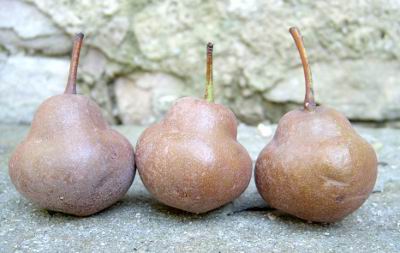︎︎︎ PERA MARZOLA

Le piante madri sono state in luoghi diversi dell’Appennino Umbro Marchigiano ma anche a Sud dell’Umbria. Non se conosce l’origine ma veniva coltivata nelle zone di alta collina, in piante singole. Nelle aree di diffusione ne sono rimasti pochissimi esemplari. Deve il suo nome al fatto che è estremamente tardiva, viene infatti raccolta a gennaio e mangiata fino a Marzo. La pianta è poco vigorosa, rustica e a portamento quasi espanso. E’ produttiva e la fioritura è molto tardiva e per questo è adatta alla coltivazione di montagna, perché sfugge alle gelate tardive fiorisce tardivamente. Il frutto è di medio-piccola pezzatura ((gr. 100-120), questa di forma turbinato appiattita, molyo accentuata, a peduncolo corto e di grossezza media. La cavità calicina è inesistente. La buccia è spessa, di colore verde omogeneo ma completamente coperta di ruggine. La polpa poco succosa e di color bianco crema, è mediamente granulosa.
Viene raccolta all’inizio di dicembre dopo le prime brinate e si conserva in fruttaio in mezzo alla paglia per la maturazione. Si conserva comunque a lungo. E’ varietà molto antica ed era apprezzata soprattutto per la notevole tardività. Estremamente rustica la pianta, il frutto, descritto fin dal 1400, era un ottima riserva per l’inverno, specialmente cotta, ma anche mangiata ammezzita, ossia quando la polpa diventa marrone. Si conserva anche attaccata al ramo, appesa al soffitto di qualche stanza asciutta e oscura, come ci insegna Marziale.
The mother plants were recovered in various parts of Umbria. Its origin is unknown but it used to be cultivated in the high hill areas. In the areas where it was widespread only a very few specimens here and there are left. Its name derives from its late maturation with its harvest time being as late as the month of March. The tree is not too vigorous, hardy, with a spreading habit and average productivity. It is extraordinarily late both in the opening of the buds and in blooming, the latter happening in May. The fruit is medium-small, markedly whirly and flattened, and with short and medium-thick stem. There is no calyx. The skin is thick, an even green but totally russeted. The flesh is not too juicy, an off-white and generally granular. It is harvested very late, around the beginning of December and it stores in the straw in the fruit-house for a long time. It can be eaten once soft or after roasting. It is a very old variety and was especially valued for its remarkable lateness. It is stored with the stem still attached to the branch and hung from the ceiling in a dark and dry room, as Marziale tells us.